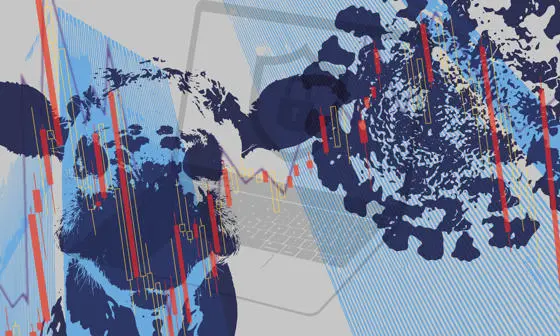Helping to predict trade flows at a time of global crisis

Contents
One of the consequences of the 2008 financial crisis, along with a drop in world GDP of one per cent, was the "Great Trade Collapse", which saw a decline in the value of global trade flows by ten per cent before rebounding. A similar experience is playing out today, with the outbreak of COVID-19 causing worldwide disruption to trade flows, with declines in trade again predicted to far exceed the drop in world GDP that occurred as a result of the pandemic.
But while a smooth flow of trade, or a quick recalibration when trade is disrupted, is vital for all world economies, there is still a lack of thorough understanding around how much the value of international trade flows adjusts as a result of a global shock, and why some countries are able to weather a time of crisis better than others.
How can we predict what might happen to trading partnerships during times of global shock?
"There are various approaches taken to identifying how countries trade with each other," says Justas Dainauskas, an LSE Fellow in the Department of Economics. "Some argue that the most accurate way is to look at how much countries have traded in the past, and that the past values of those trade flows will be the most accurate predictors of what will happen in the future. So history matters a lot. This is what we call persistent trade flows. Others say that historical patterns are only informative about which countries partner-up to trade, but not about how much is actually traded between countries, because the key indicators of present trade value are the present economic activity of the countries impacted."
"What our research has shown, is that it actually lies somewhere in the middle. History does matter even for predicting changes in trade value, but not to the same extent as has previously been thought, because when we take a solely historical perspective, we can’t really explain these big trade flow adjustments that we see when large global recessions occur."
"On the other hand, if we just rely on the present economic circumstances that don’t take into the account the historical patterns of trade, we predict even sharper declines in trade flows and speedier recoveries than the data suggest. So, the problem is trying to find this middle ground."
When countries trade with each other, they develop habits, which independently of other economic forces can contribute to the smoothness or volatility of trade flow adjustments.
Taking a new approach to predicting international trade
A new paper by Mariarosaria Comunale, Justas Dainauskas and Povilas Lastauskas sheds light on why some countries might recover their trade flows quicker than others at a time of global disruption. Taking both an empirical and theoretical perspective, it looks at how persistent trade flows are, and asks if there is a more accurate way to assess how much of the trade value gets disrupted between countries at a time of a global crisis.
The research, which the team have been asked to present to the United States International Trade Commission (USITC), provides some answers as to why particular trading partnerships are able to weather global shocks, while others take longer to realign.
"We tried to contribute to this literature in different ways," says Dr Comunale. "On the modelling side, we argue that when countries trade with each other, they develop habits, which independently of other economic forces can contribute to the smoothness or volatility of trade flow adjustments.
"It could be that two countries are trading more because of their linkages – their shared history, institutions, values, language, or even colonial ties – but also at the level of industry, so it could be that some foreign suppliers of intermediate goods are more reliable than others. So, our theory that we call habits in supply chains tries to encompass these properties of international trade."
We find that countries that rely on goods produced in other countries to make their products are far less vulnerable and likely to experience less disruption in trade flows.
Taking a theoretical and empirical look at trade flows
"We have tried to give our contribution in the empirics as well," continues Dr Comunale. "For example, we found that accounting for differences in habits across different country pairs and controlling for changes in global factors can help explain why finding a middle ground proves to be challenging. Much of the existing work focus is on inferring how trade flows between two countries adjust in response to shocks independent of their differences in economic structure and independently of how they interact with trade flows in the rest of the world. But we find that drawing these distinctions is important both in theory and in the data."
The analysis reveals that the level of countries’ production integration in the global supply chains plays a key role in how quickly they can re-establish trade flows after a global shock. Countries that export goods that are authentic, meaning that there is no integration in production technology across borders, are found to be most exposed to trade disruptions compared to those that rely on intermediate goods produced in other countries to make their final products.
While it might sound counter-intuitive at first, having connections as part of the production process, it seems, can help smooth the way at a time of global crisis. Dr Dainauskas explains: "If you are more integrated with the rest of the world, you would expect that global shocks spill over more into how much you trade and, therefore, would import more disruptions from abroad. However, we find that isn’t actually the case. We find that countries that rely on goods produced in other countries to make their products are far less vulnerable and likely to experience less disruption in trade flows. That is to say, if your country is very reliant on intermediate imports from abroad, then your trade flows will actually be smoother over time."
Dr Lastauskas adds: "To understand how persistent trade flows are between different country pairs depends largely on their level of integration on the production side, and that is why looking at our theory of habits in supply chains is so revealing. So, considering how trade persistence is affected by how integrated economies are on the supply side helps us predict how much trade flows adjust at a time of a global crisis. This hasn’t really been addressed in a single framework before."
"What we are saying is that we can’t always rely on a single parameter that is commonly referred to as the trade elasticity and use that to gauge welfare gains from trade or predict how global trade flows adjust without fully understanding the source of the differences in trade flow dynamics across countries. Our results show that it is much more important to look at what happens on the pair level between countries than previously thought. But we also have to be mindful of how changes in economic activity at the pair level can be the outcome or a consequence of shocks in the rest of the world."
These are all issues that international bodies such as the IMF and World Bank will be wrestling with. "It’s really important to see how trade in goods and services behave after a global shock," concludes Dr Comunale. "Because while building trade partnerships can be a slow process, the value of trade flows can change rapidly, especially at a time of crisis, and what is clear is that the Great Trade Collapse and the COVID-19 pandemic are unlikely to be the last international crises we face."
Download a PDF version of this article






